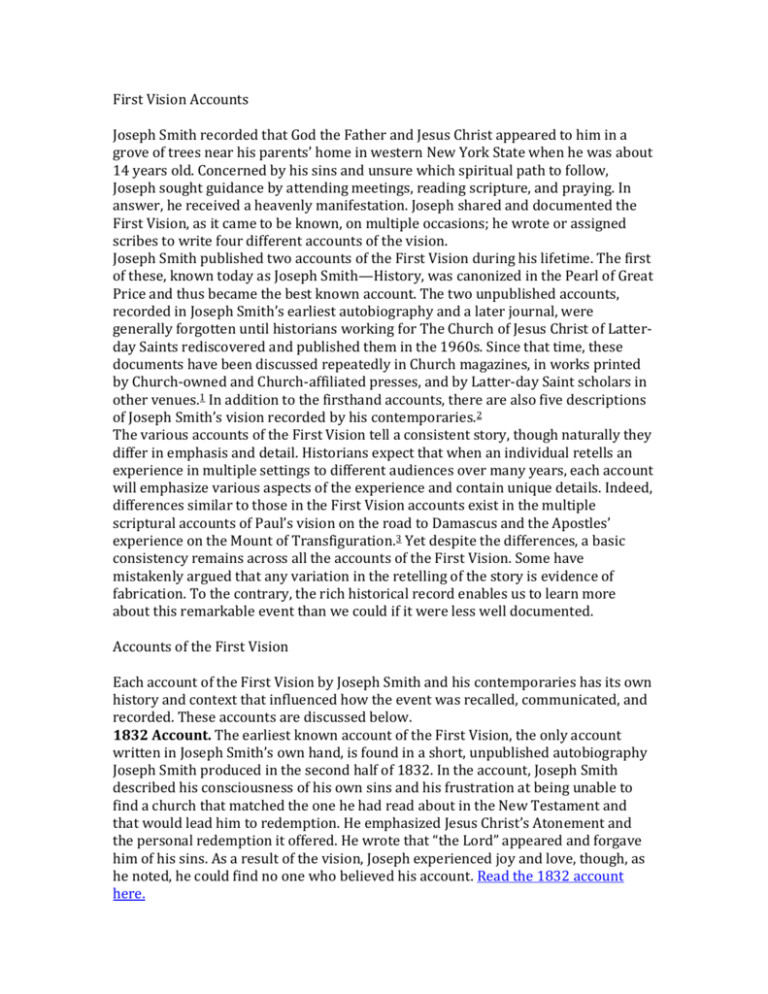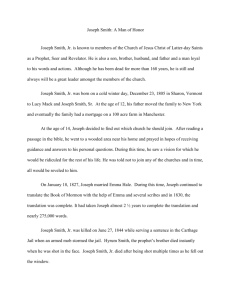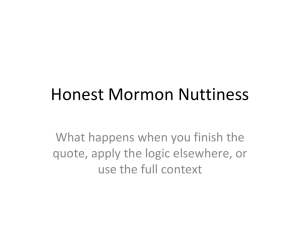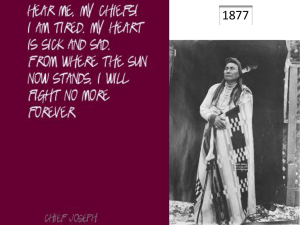
First Vision Accounts
Joseph Smith recorded that God the Father and Jesus Christ appeared to him in a
grove of trees near his parents’ home in western New York State when he was about
14 years old. Concerned by his sins and unsure which spiritual path to follow,
Joseph sought guidance by attending meetings, reading scripture, and praying. In
answer, he received a heavenly manifestation. Joseph shared and documented the
First Vision, as it came to be known, on multiple occasions; he wrote or assigned
scribes to write four different accounts of the vision.
Joseph Smith published two accounts of the First Vision during his lifetime. The first
of these, known today as Joseph Smith—History, was canonized in the Pearl of Great
Price and thus became the best known account. The two unpublished accounts,
recorded in Joseph Smith’s earliest autobiography and a later journal, were
generally forgotten until historians working for The Church of Jesus Christ of Latterday Saints rediscovered and published them in the 1960s. Since that time, these
documents have been discussed repeatedly in Church magazines, in works printed
by Church-owned and Church-affiliated presses, and by Latter-day Saint scholars in
other venues.1 In addition to the firsthand accounts, there are also five descriptions
of Joseph Smith’s vision recorded by his contemporaries.2
The various accounts of the First Vision tell a consistent story, though naturally they
differ in emphasis and detail. Historians expect that when an individual retells an
experience in multiple settings to different audiences over many years, each account
will emphasize various aspects of the experience and contain unique details. Indeed,
differences similar to those in the First Vision accounts exist in the multiple
scriptural accounts of Paul’s vision on the road to Damascus and the Apostles’
experience on the Mount of Transfiguration.3 Yet despite the differences, a basic
consistency remains across all the accounts of the First Vision. Some have
mistakenly argued that any variation in the retelling of the story is evidence of
fabrication. To the contrary, the rich historical record enables us to learn more
about this remarkable event than we could if it were less well documented.
Accounts of the First Vision
Each account of the First Vision by Joseph Smith and his contemporaries has its own
history and context that influenced how the event was recalled, communicated, and
recorded. These accounts are discussed below.
1832 Account. The earliest known account of the First Vision, the only account
written in Joseph Smith’s own hand, is found in a short, unpublished autobiography
Joseph Smith produced in the second half of 1832. In the account, Joseph Smith
described his consciousness of his own sins and his frustration at being unable to
find a church that matched the one he had read about in the New Testament and
that would lead him to redemption. He emphasized Jesus Christ’s Atonement and
the personal redemption it offered. He wrote that “the Lord” appeared and forgave
him of his sins. As a result of the vision, Joseph experienced joy and love, though, as
he noted, he could find no one who believed his account. Read the 1832 account
here.
1835 Account. In the fall of 1835, Joseph Smith recounted his First Vision to Robert
Matthews, a visitor to Kirtland, Ohio. The retelling, recorded in Joseph’s journal by
his scribe Warren Parrish, emphasizes his attempt to discover which church was
right, the opposition he felt as he prayed, and the appearance of one divine
personage who was followed shortly by another. This account also notes the
appearance of angels in the vision. Read the 1835 account here.
1838 Account. The narration of the First Vision best known to Latter-day Saints
today is the 1838 account. First published in 1842 in the Times and Seasons, the
Church’s newspaper in Nauvoo, Illinois, the account was part of a longer history
dictated by Joseph Smith between periods of intense opposition. Whereas the 1832
account emphasizes the more personal story of Joseph Smith as a young man
seeking forgiveness, the 1838 account focuses on the vision as the beginning of the
“rise and progress of the Church.” Like the 1835 account, the central question of the
narrative is which church is right. Read the 1838 account here.
1842 Account. Written in response to Chicago Democrat editor John Wentworth’s
request for information about the Latter-day Saints, this account was printed in the
Times and Seasons in 1842. (The “Wentworth letter,” as it is commonly known, is
also the source for the Articles of Faith.)4 The account, intended for publication to an
audience unfamiliar with Mormon beliefs, is concise and straightforward. As with
earlier accounts, Joseph Smith noted the confusion he experienced and the
appearance of two personages in answer to his prayer. The following year, Joseph
Smith sent this account with minor modifications to a historian named Israel Daniel
Rupp, who published it as a chapter in his book, He Pasa Ekklesia [The Whole
Church]: An Original History of the Religious Denominations at Present Existing in the
United States.5 Read the 1842 account here.
Secondhand Accounts. Besides these accounts from Joseph Smith himself, five
accounts were written by contemporaries who heard Joseph Smith speak about the
vision. Read these accounts here.
Arguments Regarding the Accounts of Joseph Smith’s First Vision
The variety and number of accounts of the First Vision have led some critics to
question whether Joseph Smith’s descriptions match the reality of his experience.
Two arguments are frequently made against his credibility: the first questions
Joseph Smith’s memory of the events; the second questions whether he embellished
elements of the story over time.
Memory. One argument regarding the accounts of Joseph Smith’s First Vision
alleges that historical evidence does not support Joseph Smith’s description of
religious revival in Palmyra, New York, and its vicinity in 1820. Some argue that this
undermines both Joseph’s claim of unusual religious fervor and the account of the
vision itself.
Documentary evidence, however, supports Joseph Smith’s statements regarding the
revivals. The region where he lived became famous for its religious fervor and was
unquestionably one of the hotbeds of religious revivals. Historians refer to the
region as “the burned-over district” because preachers wore out the land holding
camp revivals and seeking converts during the early 1800s.6 In June 1818, for
example, a Methodist camp meeting took place in Palmyra, and the following
summer, Methodists assembled again at Vienna (now Phelps), New York, 15 miles
from the Smith family farm. The journals of an itinerant Methodist preacher
document much religious excitement in Joseph’s geographic area in 1819 and 1820.
They report that Reverend George Lane, a revivalist Methodist minister, was in that
region in both years, speaking “on Gods method in bringing about Reformations.”7
This historical evidence is consistent with Joseph’s description. He said that the
unusual religious excitement in his district or region “commenced with the
Methodists.” Indeed, Joseph stated that he became “somewhat partial” to
Methodism.8
Embellishment. The second argument frequently made regarding the accounts of
Joseph Smith’s First Vision is that he embellished his story over time. This argument
focuses on two details: the number and identity of the heavenly beings Joseph Smith
stated that he saw. Joseph’s First Vision accounts describe the heavenly beings with
greater detail over time. The 1832 account says, “The Lord opened the heavens
upon me and I saw the Lord.” His 1838 account states, “I saw two Personages,” one
of whom introduced the other as “My Beloved Son.” As a result, critics have argued
that Joseph Smith started out reporting to have seen one being—“the Lord”—and
ended up claiming to have seen both the Father and the Son.9
There are other, more consistent ways of seeing the evidence. A basic harmony in
the narrative across time must be acknowledged at the outset: three of the four
accounts clearly state that two personages appeared to Joseph Smith in the First
Vision. The outlier is Joseph Smith’s 1832 account, which can be read to refer to one
or two personages. If read to refer to one heavenly being, it would likely be to the
personage who forgave his sins. According to later accounts, the first divine
personage told Joseph Smith to “hear” the second, Jesus Christ, who then delivered
the main message, which included the message of forgiveness.10 Joseph Smith’s
1832 account, then, may have concentrated on Jesus Christ, the bearer of
forgiveness.
Another way of reading the 1832 account is that Joseph Smith referred to two
beings, both of whom he called “Lord.” The embellishment argument hinges on the
assumption that the 1832 account describes the appearance of only one divine
being. But the 1832 account does not say that only one being appeared. Note that
the two references to “Lord” are separated in time: first “the Lord” opens the
heavens; then Joseph Smith sees “the Lord.” This reading of the account is consistent
with Joseph’s 1835 account, which has one personage appearing first, followed by
another soon afterwards. The 1832 account, then, can reasonably be read to mean
that Joseph Smith saw one being who then revealed another and that he referred to
both of them as “the Lord”: “the Lord opened the heavens upon me and I saw the
Lord.”11
Joseph’s increasingly specific descriptions can thus be compellingly read as evidence
of increasing insight, accumulating over time, based on experience. In part, the
differences between the 1832 account and the later accounts may have something to
do with the differences between the written and the spoken word. The 1832
account represents the first time Joseph Smith attempted to write down his history.
That same year, he wrote a friend that he felt imprisoned by “paper pen and Ink and
a crooked broken scattered and imperfect Language.” He called the written word a
“little narrow prison.”12 The expansiveness of the later accounts is more easily
understood and even expected when we recognize that they were likely dictated
accounts—an, easy, comfortable medium for Joseph Smith and one that allowed the
words to flow more easily.
Conclusion
Joseph Smith testified repeatedly that he experienced a remarkable vision of God
the Father and His Son, Jesus Christ. Neither the truth of the First Vision nor the
arguments against it can be proven by historical research alone. Knowing the truth
of Joseph Smith’s testimony requires each earnest seeker of truth to study the
record and then exercise sufficient faith in Christ to ask God in sincere, humble
prayer whether the record is true. If the seeker asks with the real intent to act upon
the answer revealed by the Holy Ghost, the truthfulness of Joseph Smith’s vision will
be manifest. In this way, every person can know that Joseph Smith spoke honestly
when he declared, “I had seen a vision, I knew it, and I knew that God knew it, and I
could not deny it.”13
Resources
1 See, for example, James B. Allen, “Eight Contemporary Accounts of the First
Vision—What Do We Learn from Them?” Improvement Era, 73, (1970): 4-13;
Richard L. Anderson, “Joseph Smith’s Testimony of the First Vision,” Ensign,
Apr. 1996, 10-21; Milton V. Backman, Joseph Smith’s First Vision: The First
Vision in Its Historical Context (Salt Lake City: Bookcraft, 1971; 2d ed., 1980);
Steven C. Harper, Joseph Smith’s First Vision: A Guide to the Historical Accounts
(Salt Lake City: Deseret Book, 2012).
2 All of these accounts were reproduced in Dean C. Jessee, “The Earliest
Documented Accounts of Joseph Smith’s First Vision,” in John W. Welch, ed.,
with Erick B. Carlson, Opening the Heavens: Accounts of Divine Manifestations,
1820–1844 (Provo and Salt Lake City: Brigham Young University Press and
Deseret Book, 2005), 1–33.
3 Acts 9:3–9; 22:6–21; 26:12–18; Matthew 17:1–13; Mark 9:2–13; Luke 9:28–
36.
4 The full letter can be found in Joseph Smith, “Church History,” Times and
Seasons 3 (Mar. 1, 1842): 706–10.
5 Joseph Smith, “Latter Day Saints,” in I. Daniel Rupp, He Pasa Ekklesia: An
Original History of the Religious Denominations at Present Existing in the
United States (Philadelphia: J. Y. Humphreys, 1844), 404–10.
6 Whitney R. Cross, The Burned-Over District: The Social and Intellectual History
of Enthusiastic Religion in Western New York, 1800-1850 (Ithaca, N.Y.: Cornell
University Press, 1950); Paul E. Johnson, A Shopkeeper’s Millennium: Society
and Revivals in Rochester, New York, 1815-1837 (New York: Hill and Wang,
1983); Nathan O. Hatch, The Democratization of American Christianity (New
Haven: Yale University Press, 1989).
7 Benajah Williams diary, July 15, 1820, copy in Church History Library, Salt
Lake City; spelling regularized.
8 1838 account (Joseph Smith—History 1:5, 8).
9 1832 account (Joseph Smith History, ca. Summer 1832, 3, in Joseph Smith,
“Letter Book A,” Joseph Smith Collection, Church History Library, Salt Lake
City); 1838 account (Joseph Smith—History 1:17).
10 1838 account (Joseph Smith—History 1:17); 1835 account (Joseph Smith,
“Sketch Book of the use of Joseph Smith, jr.,” Journal, Nov. 9–11, 1835, Joseph
Smith Collection, Church History Library, Salt Lake City.
11 1832 account (Joseph Smith History, ca. Summer 1832, 3, in Joseph Smith,
“Letter Book A,” Joseph Smith Collection, Church History Library, Salt Lake
City).
12 Joseph Smith to William W. Phelps, Nov. 27, 1832, Joseph Smith Collection,
Church History Library, Salt Lake City; available at
www.josephsmithpapers.org.
13 1838 account (Joseph Smith—History 1:25).
The Church acknowledges the contribution of scholars to the historical content
presented in this article; their work is used with permission.
Official Web site of The Church of Jesus Christ of Latter-day Saints
© 2015 Intellectual Reserve, Inc. All Rights Reserved
https://www.youtube.com/watch?v=AJgkaU08VvY Donald in Mathemagicland

![Title of the Presentation Line 1 [36pt Calibri bold blue] Title of the](http://s2.studylib.net/store/data/005409852_1-2c69abc1cad256ea71f53622460b4508-300x300.png)
![[Enter name and address of recipient]](http://s3.studylib.net/store/data/006894526_1-40cade4c2feeab730a294e789abd2107-300x300.png)



